GDP growth lowest since pandemic
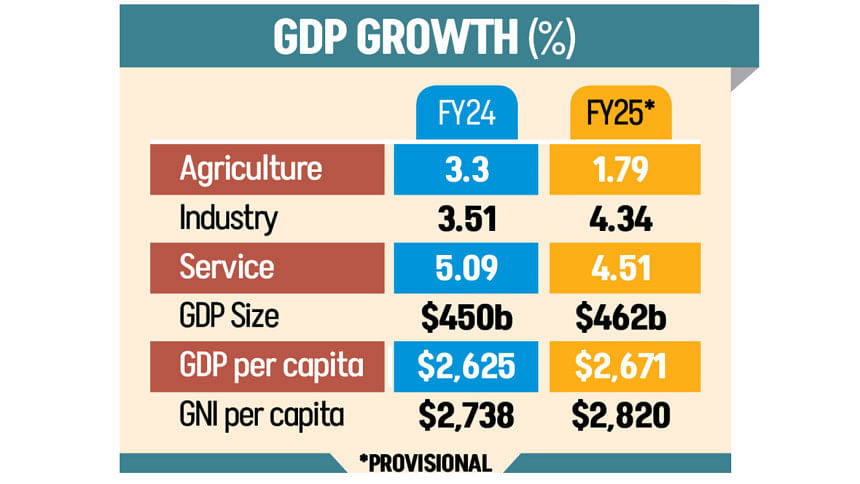
Bangladesh's GDP grew by 3.97 percent this fiscal year, the slowest in 34 years excluding the pandemic, on the back of lower growth in the agriculture and service sectors.
When the global coronavirus pandemic hit in fiscal 2019-20, the GDP growth was 3.75 percent. Otherwise, this year's provisional estimates by the Bangladesh Bureau of Statistics suggest that the economy will expand at the slowest pace since fiscal 1990-91, when it stood at 3.24 percent.
This fiscal year, the agricultural sector grew by 1.79 percent, down from 3.30 percent in fiscal 2023-24.
Service sector growth dropped 58 basis points to 4.51 percent, while the industrial sector growth jumped 83 basis points to 4.34 percent.
"This is a realistic assessment -- the World Bank and the Asian Development Bank projected similar growth estimates," said Selim Raihan, executive director of the South Asian Network on Economic Modelling.
When the ousted Awami League government prepared the budget for this fiscal year, the GDP growth projection was set at 6.75 percent. It was later revised down to 5 percent by the interim government.
However, the WB estimated the growth at 3.3 percent for the current fiscal year while the ADB estimated at 3.9 percent.
There was political instability and factory closures, while the law-and-order situation was dicey, said Raihan, also a professor of economics at the University of Dhaka.
"It's a kind of reflection of reality," he said, adding that the garment sector performed well, dragging up the overall industrial growth.
If the economic activities stagnate, the service sector growth is bound to be lower, he added.
In its Bangladesh Development Update released in April, the WB said the overall deceleration of economic activities in the first three quarters of fiscal 2024-25 was driven by a slump in both private and public investment.
Subdued private investment has been associated with declining private sector credit growth, which grew at 7.3 percent year-on-year in December 2024 -- the slowest pace of growth in 30 years, the report said.
The overall investment-to-GDP ratio was 29.38 percent, which was 30.7 percent last fiscal year, according to BBS's provisional figures. Of the amount, private investment was 22.48 percent of the GDP, which was 23.96 percent last fiscal year.
The agriculture sector faced significant challenges in the first quarter, primarily due to severe flooding, the WB report said.
"In the industrial sector, export growth provided some support, particularly in the ready-made garments (RMG). However, industrial activity outside of the RMG sector remained sluggish."
High inflation dampened consumer purchasing power, the WB said, adding that the Bangladesh Bank continued its tight monetary policy stance in the first three quarters of the fiscal year and raised the policy rate to rein in inflationary pressure.
Meanwhile, the ADB said the slowdown was driven by political instability, natural disasters, disruptions at factories due to worker protests and high inflation, all of which dampened demand.
In the service sector, wholesale and retail sales grew by 4.35 percent, which was 5.77 percent last fiscal year, according to BBS's provisional figures. The transport sector grew by 4.37 percent, which was 5.15 percent in fiscal 2023-24. Real estate activities were almost the same at 3.19 percent.
Electricity production grew 6.32 percent, which was 1.55 percent last fiscal year. The gas sector growth, however, worsened.
The size of the economy stands at $462 billion, up from $450 billion in fiscal 2023-24. The per capita income was $2,820, which was $2,738 last fiscal year.
The GDP size and per capita income should be recalculated as those are still "manipulated and inflated", said Raihan, who was part of the 12-member committee that prepared a white paper on the state of the Bangladesh economy.
"We raised a question in the report that there were big methodical problems in the national accounts as those were calculated on wrong assumptions and methods, without updated data."
The white paper said Bangladesh's economic growth has been overstated since 1995 and the practice of making inflated estimates rose after fiscal 2012-13.
"Bangladesh was seen as one of the fastest-growing economies but its growth became a paradox to many during the tenure of the previous government. The development narrative was underwritten by cooked-up GDP growth figures."
He demanded an independent data commission to identify the loopholes in national accounts, as recommended by the white paper.
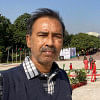

 For all latest news, follow The Daily Star's Google News channel.
For all latest news, follow The Daily Star's Google News channel. 


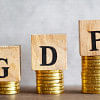
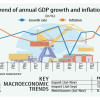

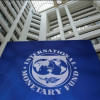


Comments